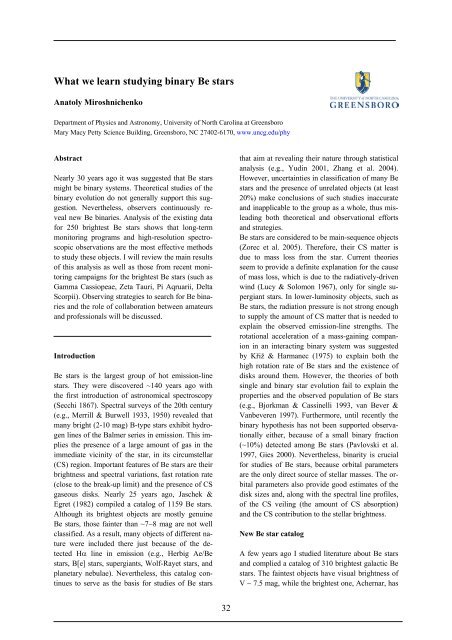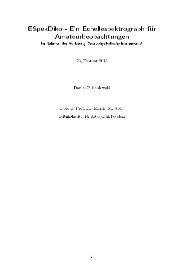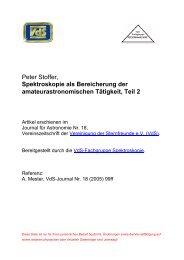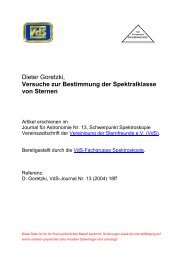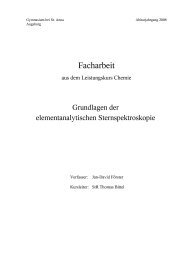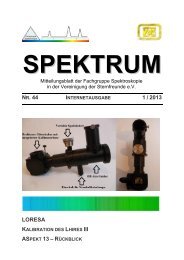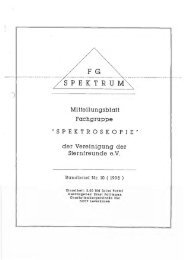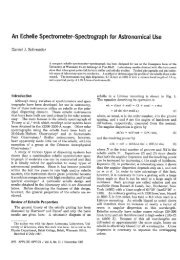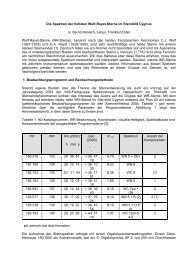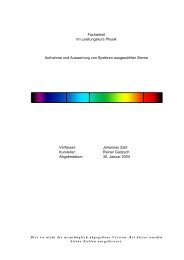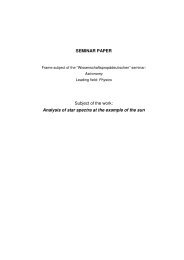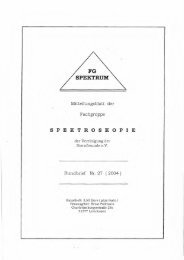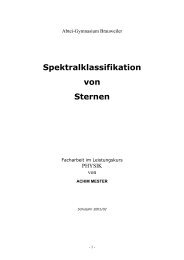Tagungsbericht der VdS-Fachgruppe SPEKTROSKOPIE
Tagungsbericht der VdS-Fachgruppe SPEKTROSKOPIE
Tagungsbericht der VdS-Fachgruppe SPEKTROSKOPIE
Sie wollen auch ein ePaper? Erhöhen Sie die Reichweite Ihrer Titel.
YUMPU macht aus Druck-PDFs automatisch weboptimierte ePaper, die Google liebt.
What we learn studying binary Be stars<br />
Anatoly Miroshnichenko<br />
Department of Physics and Astronomy, University of North Carolina at Greensboro<br />
Mary Macy Petty Science Building, Greensboro, NC 27402-6170, www.uncg.edu/phy<br />
Abstract<br />
Nearly 30 years ago it was suggested that Be stars<br />
might be binary systems. Theoretical studies of the<br />
binary evolution do not generally support this suggestion.<br />
Nevertheless, observers continuously reveal<br />
new Be binaries. Analysis of the existing data<br />
for 250 brightest Be stars shows that long-term<br />
monitoring programs and high-resolution spectroscopic<br />
observations are the most effective methods<br />
to study these objects. I will review the main results<br />
of this analysis as well as those from recent monitoring<br />
campaigns for the brightest Be stars (such as<br />
Gamma Cassiopeae, Zeta Tauri, Pi Aqruarii, Delta<br />
Scorpii). Observing strategies to search for Be binaries<br />
and the role of collaboration between amateurs<br />
and professionals will be discussed.<br />
Introduction<br />
Be stars is the largest group of hot emission-line<br />
stars. They were discovered ~140 years ago with<br />
the first introduction of astronomical spectroscopy<br />
(Secchi 1867). Spectral surveys of the 20th century<br />
(e.g., Merrill & Burwell 1933, 1950) revealed that<br />
many bright (2-10 mag) B-type stars exhibit hydrogen<br />
lines of the Balmer series in emission. This implies<br />
the presence of a large amount of gas in the<br />
immediate vicinity of the star, in its circumstellar<br />
(CS) region. Important features of Be stars are their<br />
brightness and spectral variations, fast rotation rate<br />
(close to the break-up limit) and the presence of CS<br />
gaseous disks. Nearly 25 years ago, Jaschek &<br />
Egret (1982) compiled a catalog of 1159 Be stars.<br />
Although its brightest objects are mostly genuine<br />
Be stars, those fainter than ~7�8 mag are not well<br />
classified. As a result, many objects of different nature<br />
were included there just because of the detected<br />
H� line in emission (e.g., Herbig Ae/Be<br />
stars, B[e] stars, supergiants, Wolf-Rayet stars, and<br />
planetary nebulae). Nevertheless, this catalog continues<br />
to serve as the basis for studies of Be stars<br />
32<br />
that aim at revealing their nature through statistical<br />
analysis (e.g., Yudin 2001, Zhang et al. 2004).<br />
However, uncertainties in classification of many Be<br />
stars and the presence of unrelated objects (at least<br />
20%) make conclusions of such studies inaccurate<br />
and inapplicable to the group as a whole, thus misleading<br />
both theoretical and observational efforts<br />
and strategies.<br />
Be stars are consi<strong>der</strong>ed to be main-sequence objects<br />
(Zorec et al. 2005). Therefore, their CS matter is<br />
due to mass loss from the star. Current theories<br />
seem to provide a definite explanation for the cause<br />
of mass loss, which is due to the radiatively-driven<br />
wind (Lucy & Solomon 1967), only for single supergiant<br />
stars. In lower-luminosity objects, such as<br />
Be stars, the radiation pressure is not strong enough<br />
to supply the amount of CS matter that is needed to<br />
explain the observed emission-line strengths. The<br />
rotational acceleration of a mass-gaining companion<br />
in an interacting binary system was suggested<br />
by Křiž & Harmanec (1975) to explain both the<br />
high rotation rate of Be stars and the existence of<br />
disks around them. However, the theories of both<br />
single and binary star evolution fail to explain the<br />
properties and the observed population of Be stars<br />
(e.g., Bjorkman & Cassinelli 1993, van Bever &<br />
Vanbeveren 1997). Furthermore, until recently the<br />
binary hypothesis has not been supported observationally<br />
either, because of a small binary fraction<br />
(~10%) detected among Be stars (Pavlovski et al.<br />
1997, Gies 2000). Nevertheless, binarity is crucial<br />
for studies of Be stars, because orbital parameters<br />
are the only direct source of stellar masses. The orbital<br />
parameters also provide good estimates of the<br />
disk sizes and, along with the spectral line profiles,<br />
of the CS veiling (the amount of CS absorption)<br />
and the CS contribution to the stellar brightness.<br />
New Be star catalog<br />
A few years ago I studied literature about Be stars<br />
and complied a catalog of 310 brightest galactic Be<br />
stars. The faintest objects have visual brightness of<br />
V ~ 7.5 mag, while the brightest one, Achernar, has


